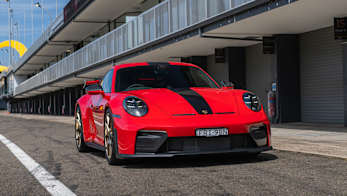Volkswagen has revealed that it started working on the new Amarok’s looks before the deal with Ford to provide the latest Ranger as a base had been nutted out.
According to Volkswagen Commercial Vehicles Head of Exterior Design as well former Head of the Design Studio Australia, the idea of what an Amarok replacement should look like had been discussed extensively and determined with a very clear vision.
“We began sketching the Amarok before (Ford’s involvement),” he told CarsGuide at the launch of the NF Amarok in Victoria last week.
“We knew what we had to include… I started sketching the next Amarok back in about August 2018.”
Mr Kim, who was also the VW head of the Australian project, added that the sketches that were to become the second-gen ute were refined and evolved right through April 2019, with the design freeze taking place in about April 2020 at VW’s studio in Melbourne.
“I spent more than three-and-a-half years in Australia together with the design team,” he said. “It was our task to work on the design for the new VW Amarok, and to also make sure the car would fulfil our customers’ expectations.”
At the time, there were more than 20 VW designers and engineers working in collaboration with Ford Australia on the T6 Ranger-based Amarok, resulting in VW-specific design and engineering changes to meet the brand’s standards.
From a design perspective, that meant having a ute that is identifiably Amarok – given Australia is its biggest market – but with a larger, broader and more-modern, more-SUV-like stance that moves away from the more-utilitarian and conservative styling elements of the original.
Melding traditional Amarok themes into a fundamentally different ute with the Ranger hardpoints already in place proved to be extremely challenging for VW’s designers.
.jpg)
“It was a tough task,” Mr Kim admitted. “To create a true VW. And the new Amarok had to reflect the VW design identity, the VW DNA.”
To achieve this, there were three design elements that were “non-negotiables” from a styling perspective.
The first was to ensure a “Clear Line” language – where a continuous line can be drawn from the base of the A-pillar, up through the roof and down the C-pillar, and then back along the shoulder line to the front. Similarly, inside, both doors are connected by a line that runs along the dashboard.
The second was to achieve “Closed Volumes” – where the lights and grille are enclosed in a T-shape reminiscent of many other contemporary VWs, and that’s also repeated in the instrument panel, with a continuous line from one side of the door cards to the dash and lower console and then back up on through to the door card on the other side.
.jpg)
“This creates a huge, enclosed volume”, Mr Kim explained.
The third was what VW calls “Iconographic” details that needed to be included, such as the LED light graphics that feature a “kink in the eyes” for a more-expressive and identifiable appearance, as well as C-shaped elements peppered throughout inside and within the LED tail-light design and tailgate structure to emphasise width and purpose.
These, along with embossing the word ‘AMAROK’ across the rear, is a way of clearly differentiating the VW from its Ranger fraternal twin from a distance as well as in the dark.
Yet the VW designer was keen to include design details that enhanced ute functionality. Among these are the fluted bonnet with the lower ridges created so the driver can see more of the road, particularly when off-roading. Another is the recessed foglight housing down in the lower-bumper area, to protect the LEDs as they otherwise can be exposed to damage.
.jpg)
The latest Amarok still carries through the squared-off wheelarches deemed essential in connecting new with old, but they are flared in a more-muscular way to improve stance and 4WD-intent. They also sit within more structured sheetmetal surfaces with a machined look, to give it a far-more contemporary feel.
Finally, having five distinctive front-end looks within the one model range was deemed important for the new-gen Amarok, as the previous one’s predominantly single-themed appearance was thought to have limited its appeal to buyers who seek different elements in their utes for varying reasons.
To that end, the base Core retains a workhorse-like visage, the Life has more monochrome aspects for a wider and more horizontal look, while the expected-bestselling Style looks this way to be what VW calls “the elegant street cruiser”. Finally, the blacked-out ‘X’-shape grille helps give the PanAmericana its rugged off-road focus, while giving that a chrome finish denotes the Aventura flagship as the luxury one with on-road performance.
Striving for a consistent design within a “masculine” architecture inside and out was the ultimate goal in progressing the Amarok from old to new, without going too aggressive as per most rival utes.
“Inside and outside this car is a real VW… it was designed in Australia for Australia,” Mr Kim said.
.jpg)
This is no surprise, given that some 10 per cent of total global Amarok volume ended up in this country.
The level of commitment in differentiating the Amarok from the Ranger contrasts starkly to the last time VW had to rely on another carmaker’s hardware.
In 1989 the fifth-generation Toyota HiLux was rebadged as the VW Taro. Available until 1997, that was basically the extent of the changes, even though the latter was built from completely knocked-down parts imported from Japan. Sales were slow and the venture did not proceed from there.













.jpg)

.jpg)
.jpg)


.jpg)

.jpg)






.jpg)
.jpg)
